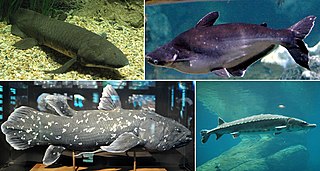Sunfish or sun-fish may refer to:

Osteichthyes, also known as osteichthyans or commonly referred to as the bony fish, is a diverse superclass of vertebrate animals that have endoskeletons primarily composed of bone tissue. They can be contrasted with the Chondrichthyes and the extinct placoderms and acanthodians, which have endoskeletons primarily composed of cartilage. The vast majority of extant fish are members of Osteichthyes, being an extremely diverse and abundant group consisting of 45 orders, over 435 families and 28,000 species. It is the largest class of vertebrates in existence today, encompassing most aquatic vertebrates, as well as all semi-aquatic and terrestrial vertebrates.
Oscar, OSCAR, or The Oscar may refer to:

The ocean sunfish or common mola is one of the largest bony fish in the world. It was misidentified as the heaviest bony fish, which was actually a different and closely related species of sunfish, Mola alexandrini. Adults typically weigh between 247 and 1,000 kg. The species belongs to the Mola genus, one of three in the Molidae family. It is native to tropical and temperate waters around the world. It resembles a fish head without a tail, and its main body is flattened laterally. Sunfish can be as tall as they are long when their dorsal and ventral fins are extended.
Whiting is the name of
The United States is a country located mainly in North America.

USS Sunfish (SSN-649), a Sturgeon-class attack submarine, was the second ship of the United States Navy to be named for the ocean sunfish, a marine species having a deep body truncated behind, and high dorsal and anal fins.

The Molidae comprise the family of the molas or ocean sunfishes, unusual fish whose bodies come to an end just behind the dorsal and anal fins, giving them a "half-fish" appearance. They are also the largest of the ray-finned bony fish, with the southern sunfish, Mola alexandrini, recorded at 4.6 m (15 ft) in length and 2,744 kg (6,049 lb) in weight.
Two ships of the United States Navy have borne the name USS Sunfish, named in honor of the ocean sunfish, Mola mola, a plectognath marine fish, having a deep body truncated behind, and high dorsal and anal fins.

The first USS Sunfish (SS-281), a Gato-class submarine, was the first ship of the United States Navy to be named for the ocean sunfish, Mola mola, a plectognath marine fish, having a deep body truncated behind, and high dorsal and anal fins.
Mola can refer to:

The North Pacific albatrosses are large seabirds from the genus Phoebastria in the albatross family. They are the most tropical of the albatrosses, with two species nesting in the Northwestern Hawaiian Islands, one on sub-tropical islands south of Japan, and one nesting on the equator.
Moonfish may refer to several groups of fishes:

The slender sunfish is a mola of the family Molidae, the only extant member of the genus Ranzania, found globally in tropical and temperate seas. Its length is up to 1 m (3.3 ft). Several stranding and mass stranding events have occurred on beaches near Albany, Western Australia.
The flying fish is a marine fish family consisting of approximately 70 species.

A sunfish, also called a mola, is any fish in the genus Mola. The fish develop their truncated, bullet-like shape because the back fin, which is present at birth, never grows. Instead, it folds into itself as the creature matures, creating a rounded rudder called a clavus. Mola in Latin means "millstone" and describes the ocean sunfish's somewhat circular shape. They are a silvery color and have a rough skin texture.
A bream is a common name for numerous species of fish, particularly Abramis brama.

The sharptail mola is a species of mola found circumglobally in tropical and temperate waters. It is similar in appearance to the ocean sunfish, but can be distinguished by the projection on its clavus (pseudo-tail). Other common names include sharpfin sunfish, point-tailed sunfish, and trunkfish. Rarely encountered, very little is known of the biology or life history of the sharptail mola. It has recently become important to commercial fisheries operating off eastern Taiwan. This species is the only member of its genus.

The giant sunfish or bumphead sunfish, , is a fish belonging to the family Molidae. It is closely related to the more widely known Mola mola, and is found in the Southern Hemisphere. With a specimen found dead near the Azores in 2021 weighing in at 2744 kg it is the largest extant bony fish species in terms of maximum recorded mass by a wide margin. It can be found basking on its side occasionally near the surface, which is thought to be used to re-heat themselves after diving in cold water for prey, recharge their oxygen stores, and attract gulls to free them of parasites.

Mola tecta, the hoodwinker sunfish, belongs to the family Molidae and genus Mola. It is closely related to the more widely known ocean sunfish. The Latin word "tecta" means hidden. The word "hidden" was adopted for the name because the fish has blended in among other species of sunfish for a long time and has only been discovered recently. Discovered on a beach near Christchurch, New Zealand, in 2015, it was the first new species of sunfish to be identified in 130 years. Mola tecta are mostly discovered in the temperate region of the Southern Hemisphere in the water near Australia, New Zealand, Southern Chile and Southern Africa. It was first described by Marianne Nyegaard, a marine scientist who studied ocean sunfish for her PhD.
Marianne Nyegaard is a Danish marine biologist who specializes in the study of ocean sunfish. She is known for identifying the ocean sunfish species Mola tecta.